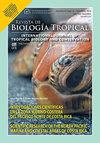危地马拉海牛和小牛(Trichechus manatus Sirenia: Trichechus manatus Sirenia)的长期时空分布、丰度和优先区域
IF 0.6
4区 生物学
Q4 BIOLOGY
引用次数: 1
摘要
简介:安的列斯海牛(学名:Trichechus manatus manatus)是一种濒临灭绝的物种,分布在整个加勒比地区以及南美洲中部和东北部的沿海水域。它们的数量少是各种与人类有关的压力的结果。在危地马拉发现了一小群海牛;然而,它们的时空动态仍不清楚。 目的:研究危地马拉海牛的时空分布和丰度的长期趋势。这包括确定海牛的优先区域,包括小牛的存在,评估分布区域是否在保护区内,以及研究海牛目击与人类活动之间的关系。方法:在1992年、2005-2008年、2010-2011年、2014年和2022年对大西洋沿岸进行了9年标准化航空调查。在时空分析中使用了定量方法来检测优先区域,特别是核密度估计和Getis-Ord Gi*统计。斯皮尔曼等级相关分析测试了人类活动、海岸线地形和沿海岸段海牛数量之间的显著相关性。研究人员还检查了海牛在不同年份、调查区域和保护区的丰度。结果:共发现海牛293只,518只,其中成年海牛476只(92%),幼海牛42只(8%)。海牛最常被观察到为独居个体(60%)。大多数海牛(61%)和小牛(68%)的目击事件发生在保护区内,这些保护区确定了几个优先区域。两个优先区域是1992年被确定为重要海牛栖息地的维达西尔维斯特博卡斯德尔波洛奇和维达西尔维斯特Punta de Manabique保护区。Bocas del Polochic海牛丰度在所有保护区中最高(p <0.05)。然而,2014年记录了海牛分布的变化,尽管原因尚不清楚。海牛丰度随时间变化无显著的年度差异(p = 1.0),但在调查断面和保护区之间发现了显著的丰度差异(p <0.05)。海牛数量与生态参数和人类参数呈显著正相关。相关性最高的是海牛和河流(p <0.01),海牛、摩托艇和渔网之间的相关性最弱(p <0.01)强生# x0D;结论:20多年来,海牛种群总体分布发生变化,但总体保持相对稳定。目前还不清楚这些变化是暂时的还是永久性的。作为一种哨兵物种,海牛的分布变化可以作为环境健康的早期预警,并可以描述对个体和种群水平的动物健康的当前或潜在影响。本文章由计算机程序翻译,如有差异,请以英文原文为准。
Long-term spatiotemporal distribution, abundance, and priority areas for manatees and calves (Trichechus manatus Sirenia: Trichechidae) in Guatemala
Introduction: The Antillean manatee (Trichechus manatus manatus) is an endangered species found throughout the Caribbean, and the coastal waters of Central and northeastern South America. Their low numbers are the result of a variety of human-related pressures. A small population of manatees has been identified in Guatemala; however, their spatial and temporal dynamics remain unclear.
Objective: To examine long-term trends in the spatiotemporal distribution and abundance of manatees in Guatemala. This included identification of priority areas for manatees including the presence of calves, assessing whether distribution areas are inside protected areas, and studying the relationship between manatee sightings and human activities.
Methods: Nine years of standardized aerial surveys were conducted along the Atlantic coast (1992, 2005-2008, 2010-2011, 2014, 2022). Quantitative approaches to detect priority areas, specifically the Kernel density estimation and the Getis-Ord Gi* statistic, were used in the spatiotemporal analysis. A Spearman rank correlation analysis tested for significant correlations between human activities, coastline topographies, and manatee numbers along coastline segments. Manatee abundance across years, survey sections, and protected areas were also examined.
Results: A total of 293 sightings and 518 manatees were observed including 476 adults (92 %) and 42 calves (8 %). Manatees were most frequently observed as solitary individuals (60 %). Most manatee (61 %) and calf (68 %) sightings occurred inside protected areas where several priority areas were identified. The two priority areas were Refugio de Vida Silvestre Bocas del Polochic (Bocas del Polochic) and Refugio de Vida Silvestre Punta de Manabique, which were identified as important manatee habitats in 1992. Bocas del Polochic had the highest manatee abundance of all protected areas (p < 0.05). However, a shift in manatee distribution was recorded in 2014, although the cause is unclear. No annual significant differences in manatee abundance were found over time (p = 1.0), but significant differences in abundance were detected between survey sections and protected areas (p < 0.05). Manatee numbers had positive significant correlations with ecological and human parameters. The highest correlation was between manatees and rivers (p < 0.01), and the weakest correlation was between manatees, motorboats, and fishing nets (p < 0.01).
Conclusions: The results indicate that the local manatee population remained relatively stable for over 20 years, although changes in overall distribution were noted. It is unclear if the changes are temporary or permanent. As a sentinel species, manatee distribution shifts can be used as early warnings about the health of the environment and can depict current or potential impacts on individual- and population-level animal health.
求助全文
通过发布文献求助,成功后即可免费获取论文全文。
去求助
来源期刊

Revista De Biologia Tropical
生物-生物学
CiteScore
1.80
自引率
0.00%
发文量
23
审稿时长
4-8 weeks
期刊介绍:
The Revista de Biología Tropical / International Journal of Tropical Biology and Conservation is a mainstream scientific journal published since 1953 and covered by Web of Science; Science Citation Index; Current Contents; Google Scholar; Scopus, SciELO and nearly 50 additional indices.
A double blind system guarantees you a fair evaluation, and our world class editorial and scientific boards provides a first decision in three working days. The journal is Full Open Access and is widely read where your article can have the highest real impact.
Since its beginning in 1953, the Revista follows these principles: objective and independent evaluation of all manuscripts; transparency in all processes; ethical use of procedures, data, specimens and subjects; fair treatment of all parties; and absolute predominance of scientific rigor over any other aspect.
 求助内容:
求助内容: 应助结果提醒方式:
应助结果提醒方式:


